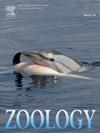Back to the water II: Variation in eye and cranial morphology in Telmatobius frogs with different lifestyles
IF 1.6
3区 生物学
Q2 ZOOLOGY
引用次数: 0
Abstract
Several tetrapod lineages have independently evolved an aquatic lifestyle, driving structural and functional modifications. Changes in eye size and position are key trends in this transition. While most frogs and toads have aquatic larvae, the majority of adults are terrestrial. In contrast, Telmatobius frogs exhibit a unique spectrum from semiaquatic to strictly aquatic lifestyles, linked to the colonization of the Andean highlands. This study examines variation in eye size, position, and cranial proportions, in two species: the semi-aquatic Telmatobius oxycephalus and the strictly aquatic T. rubigo. Measurements across post-metamorphic stages were used to compare groups and assess allometric patterns. Telmatobius rubigo, which inhabits high altitudes, has smaller eyes and a more dorsal/frontal eye position than T. oxycephalus. Among T. oxycephalus, the forest population at lower elevations has larger eyes compared to valley counterparts at intermediate altitudes. Cranial analysis reveals that T. rubigo has smaller orbits and larger otic capsules, while T. oxycephalus shows the opposite pattern. These findings suggest that smaller eye size and more frontal/dorsal positioning evolved in response to the aquatic lifestyle at high elevations. This pattern parallels that of highly aquatic pipid frogs, which adapted to aquatic habitats during the Cretaceous. In contrast, Telmatobius specialization for aquatic environments is relatively recent and associated with Andean colonization, providing a unique opportunity to study an adaptive radiation within a modern evolutionary context.
回到水II:不同生活方式的端毛蛙眼睛和头颅形态的变化
一些四足动物谱系独立地进化出了一种水生生活方式,推动了结构和功能的改变。眼睛大小和位置的变化是这种转变的关键趋势。虽然大多数青蛙和蟾蜍的幼虫是水生的,但大多数成年蛙是陆生的。相比之下,狐尾蛙表现出从半水生到严格水生的独特生活方式,这与安第斯高地的殖民化有关。本研究考察了两个物种的眼睛大小、位置和颅骨比例的变化:半水生的尖头鱼和严格水生的红尾鱼。跨后变质阶段的测量用于比较组和评估异速生长模式。生活在高海拔地区的红尾鲷的眼睛更小,眼睛位置更靠后或靠前。低海拔的森林种群比中等海拔的山谷种群具有更大的眼睛。颅部分析显示,红头绦虫的眼眶较小,耳囊较大,而头尾绦虫则相反。这些发现表明,更小的眼睛尺寸和更多的正面/背面定位是对高海拔水生生活方式的反应。这种模式与高度水生的蛙类相似,它们在白垩纪适应了水生栖息地。相比之下,Telmatobius在水生环境中的特化相对较晚,与安第斯山脉的殖民有关,为研究现代进化背景下的适应性辐射提供了独特的机会。
本文章由计算机程序翻译,如有差异,请以英文原文为准。
求助全文
约1分钟内获得全文
求助全文
来源期刊

Zoology
生物-动物学
CiteScore
3.90
自引率
0.00%
发文量
37
审稿时长
70 days
期刊介绍:
Zoology is a journal devoted to experimental and comparative animal science. It presents a common forum for all scientists who take an explicitly organism oriented and integrative approach to the study of animal form, function, development and evolution.
The journal invites papers that take a comparative or experimental approach to behavior and neurobiology, functional morphology, evolution and development, ecological physiology, and cell biology. Due to the increasing realization that animals exist only within a partnership with symbionts, Zoology encourages submissions of papers focused on the analysis of holobionts or metaorganisms as associations of the macroscopic host in synergistic interdependence with numerous microbial and eukaryotic species.
The editors and the editorial board are committed to presenting science at its best. The editorial team is regularly adjusting editorial practice to the ever changing field of animal biology.
 求助内容:
求助内容: 应助结果提醒方式:
应助结果提醒方式:


